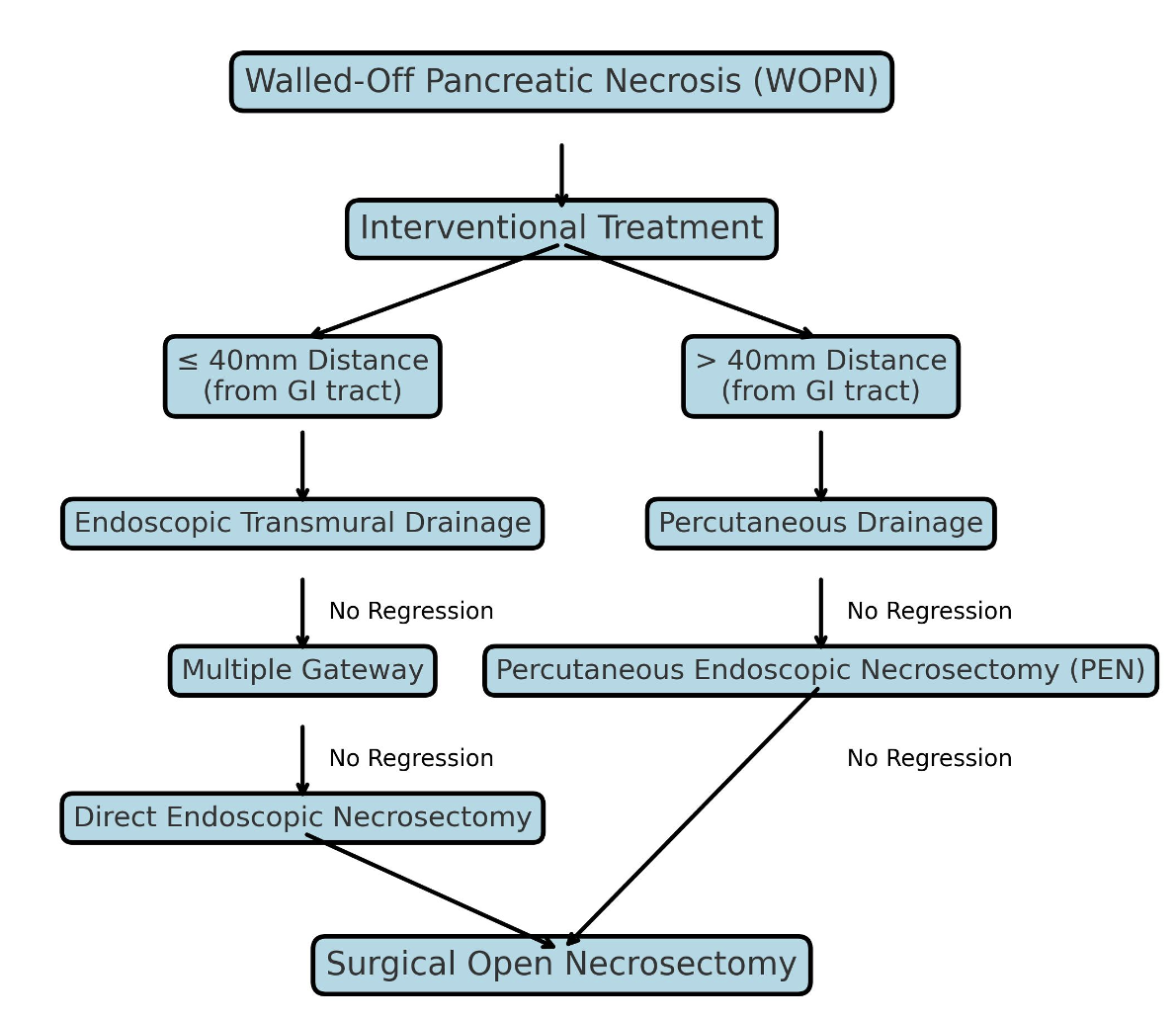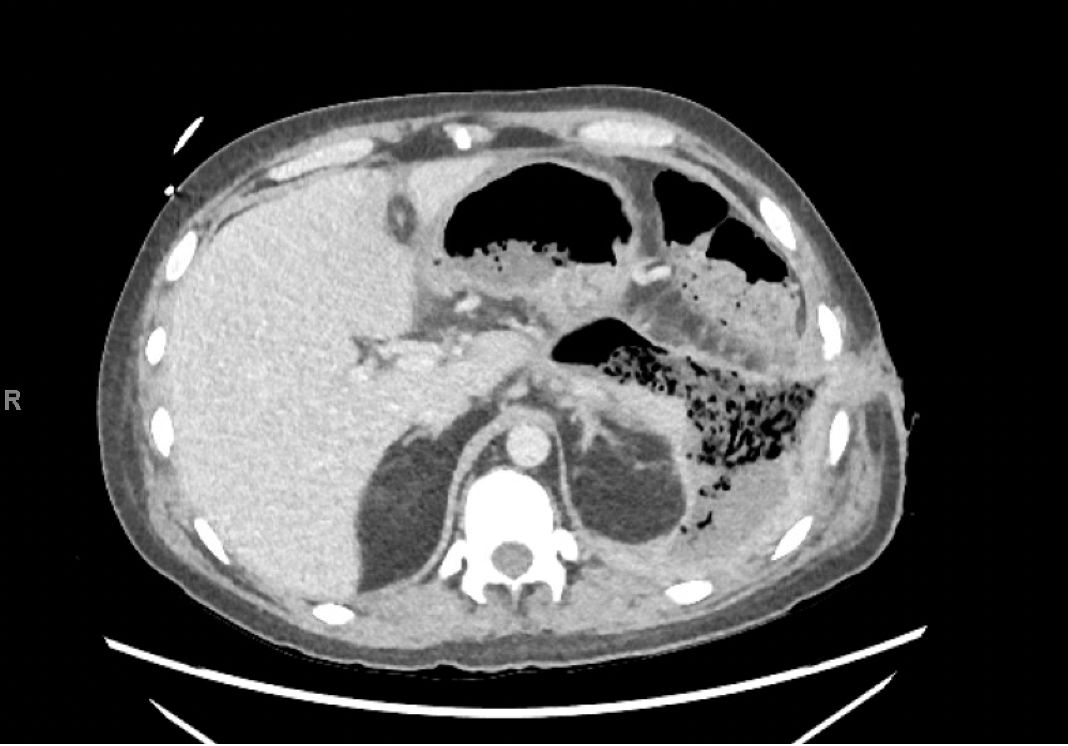Monday Poster Session
Category: Interventional Endoscopy
P3563 - Percutaneous Endoscopic Necrosectomy for Infected Pancreatic Necrosis: A Minimally Invasive Salvage Approach
Monday, October 27, 2025
10:30 AM - 4:00 PM PDT
Location: Exhibit Hall
.jpg)
Hamza Khan, MD
Midwestern University
Cottonwood, AZ
Presenting Author(s)
Hamza Khan, MD1, Farhoud Khosravi, MD2, Ritu Yadav, MD1
1Midwestern University, Cottonwood, AZ; 2NORTHERN ARIZONA HEALTHCARE, Flagstaff, AZ
Introduction: Walled-off necrosis (WON) is a late sequela of necrotizing pancreatitis. While endoscopic step-up therapy is the preferred approach for managing infected WON adjacent to the gastrointestinal tract, collections in anatomically inaccessible locations may require alternative strategies such as percutaneous endoscopic necrosectomy (PEN).
Case Description/
Methods: A 28-year-old man with alcohol use disorder presented with recurrent alcoholic pancreatitis, progressing to necrotizing pancreatitis requiring mechanical ventilation and emergency decompressive laparotomy for abdominal compartment syndrome. Despite serial laparotomies and initial clinical improvement, imaging revealed an 8.8 cm necrotic collection in the left upper quadrant with extensive retroperitoneal involvement. Due to the collection’s anterior and lateral position, EUS-guided drainage was not feasible. Interventional radiology attempted percutaneous drainage but mislocalized the collection. The patient subsequently developed signs of infected necrosis including fever, leukocytosis (35,000/µL), and tachycardia. He underwent open surgical necrosectomy with persistent pancreaticocutaneous fistula. Given residual necrotic burden, PEN was performed through the existing fistula tract. A therapeutic endoscope was advanced into the cavity, and extensive necrosectomy was completed using snares, forceps, and an automated tissue extractor. Following PEN, the patient showed marked clinical improvement, resolution of leukocytosis, and stabilization without further need for intervention.
Discussion: This case illustrates the utility of PEN as a salvage option for treating infected WON not amenable to traditional endoscopic approaches. PEN enables direct debridement of necrotic tissue through a percutaneous tract, offering a minimally invasive alternative to repeat surgery. Studies have demonstrated comparable success rates between PEN and endoscopic transmural necrosectomy in anatomically unfavorable cases. While PEN demands advanced endoscopic expertise and carries procedural risks, it can significantly reduce morbidity and hospital stay when appropriately applied. This case underscores the evolving multidisciplinary strategies in managing complex pancreatic necrosis and supports PEN as a viable therapeutic modality.

Figure: Demonstrates WON (Walled off Pancreatic Necrosis) located in the lesser sac

Figure: Demonstrates the Endoscopic Step up approach in managing WON (Walled off Pancreatic Necrosis)
Disclosures:
Hamza Khan indicated no relevant financial relationships.
Farhoud Khosravi indicated no relevant financial relationships.
Ritu Yadav indicated no relevant financial relationships.
Hamza Khan, MD1, Farhoud Khosravi, MD2, Ritu Yadav, MD1. P3563 - Percutaneous Endoscopic Necrosectomy for Infected Pancreatic Necrosis: A Minimally Invasive Salvage Approach, ACG 2025 Annual Scientific Meeting Abstracts. Phoenix, AZ: American College of Gastroenterology.
1Midwestern University, Cottonwood, AZ; 2NORTHERN ARIZONA HEALTHCARE, Flagstaff, AZ
Introduction: Walled-off necrosis (WON) is a late sequela of necrotizing pancreatitis. While endoscopic step-up therapy is the preferred approach for managing infected WON adjacent to the gastrointestinal tract, collections in anatomically inaccessible locations may require alternative strategies such as percutaneous endoscopic necrosectomy (PEN).
Case Description/
Methods: A 28-year-old man with alcohol use disorder presented with recurrent alcoholic pancreatitis, progressing to necrotizing pancreatitis requiring mechanical ventilation and emergency decompressive laparotomy for abdominal compartment syndrome. Despite serial laparotomies and initial clinical improvement, imaging revealed an 8.8 cm necrotic collection in the left upper quadrant with extensive retroperitoneal involvement. Due to the collection’s anterior and lateral position, EUS-guided drainage was not feasible. Interventional radiology attempted percutaneous drainage but mislocalized the collection. The patient subsequently developed signs of infected necrosis including fever, leukocytosis (35,000/µL), and tachycardia. He underwent open surgical necrosectomy with persistent pancreaticocutaneous fistula. Given residual necrotic burden, PEN was performed through the existing fistula tract. A therapeutic endoscope was advanced into the cavity, and extensive necrosectomy was completed using snares, forceps, and an automated tissue extractor. Following PEN, the patient showed marked clinical improvement, resolution of leukocytosis, and stabilization without further need for intervention.
Discussion: This case illustrates the utility of PEN as a salvage option for treating infected WON not amenable to traditional endoscopic approaches. PEN enables direct debridement of necrotic tissue through a percutaneous tract, offering a minimally invasive alternative to repeat surgery. Studies have demonstrated comparable success rates between PEN and endoscopic transmural necrosectomy in anatomically unfavorable cases. While PEN demands advanced endoscopic expertise and carries procedural risks, it can significantly reduce morbidity and hospital stay when appropriately applied. This case underscores the evolving multidisciplinary strategies in managing complex pancreatic necrosis and supports PEN as a viable therapeutic modality.

Figure: Demonstrates WON (Walled off Pancreatic Necrosis) located in the lesser sac

Figure: Demonstrates the Endoscopic Step up approach in managing WON (Walled off Pancreatic Necrosis)
Disclosures:
Hamza Khan indicated no relevant financial relationships.
Farhoud Khosravi indicated no relevant financial relationships.
Ritu Yadav indicated no relevant financial relationships.
Hamza Khan, MD1, Farhoud Khosravi, MD2, Ritu Yadav, MD1. P3563 - Percutaneous Endoscopic Necrosectomy for Infected Pancreatic Necrosis: A Minimally Invasive Salvage Approach, ACG 2025 Annual Scientific Meeting Abstracts. Phoenix, AZ: American College of Gastroenterology.
